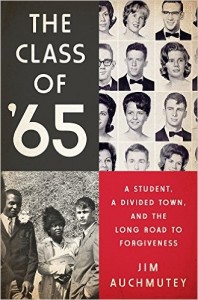The Class of ’65: A Student, a Divided Town, and the Long Road to Forgiveness
Reviewed by David Etheridge
January 1, 2016
 By Jim Auchmutey. PublicAffairs, 2015. 270 pages. $25.99/hardcover; $17.99/eBook.
By Jim Auchmutey. PublicAffairs, 2015. 270 pages. $25.99/hardcover; $17.99/eBook.
Buy on FJ Amazon Store
In the fall of 1960, the school board of Americus, Ga., refused to enroll three teenagers in the high school on the ground that their presence would be disruptive and create “an explosive situation.” That decision was overruled by a federal court. Such litigation was not unusual following the Supreme Court decision Brown v. Board of Education in 1954. What made this case different, however, is that the students seeking admission to the all-white high school were white.
They came from families of white Christians who lived on a farm outside of Americus named Koinonia (pronounced coin-o-KNEE-ah), the Greek word used in the second chapter of Acts to describe a group of Christians who shared their resources and lived together. Both their pacifism and their friendliness with their black neighbors made them unwelcome in the white high school.
The Class of ’65 recounts the harassment faced by the Koinonia teenagers in 1960, but the focus of the book is a bit later, on the 1964–5 school year, when they were joined for the first time by black teenagers. That was senior year for Greg Wittkamper, one of the Koinonia teenagers. He already personally knew the black students who were integrating the school and joined them in the car that brought them to school on the first day of classes.
Although much of the white community in Americus were annoyed by the presence of a few white people who clearly rejected their perspective, they found the black students much more upsetting. The level of harassment for both the Koinonia teenagers and the black students escalated. Most of the harassment was the work of a handful of students but with the silent acquiescence of virtually everyone else.
Jim Auchmutey, a longtime Georgia journalist and not one of the students, wrote The Class of ’65 because of what happened much later. In 2006, a few students who had been silent in 1965 and were approaching 60 years of age wrote to Wittkamper apologizing for their silence and inviting him to a somewhat belated fortieth reunion. Wittkamper connected with Auchmutey through a mutual acquaintance.
With Wittkamper as his guide, Auchmutey covers Wittkamper’s entire life—from his childhood leading up to his senior year in high school, to his involvement with Friends World Institute, to his settling down in West Virginia, and to his receipt of the letters of apology from classmates.
But the author covers much more than Wittkamper’s life. He gives us the history of Koinonia, including its later involvement in the creation of Habitat for Humanity as well as the book The Cotton Patch Gospel of Matthew and John. He devotes a chapter to civil rights turmoil in Americus in the year following Wittkamper’s graduation. There is also biographical material about some of Wittkamper’s black teenage friends and about Robertiena Freeman, one of the first black students to graduate from Americus High School. Also included are individual accounts of the journey of four of Wittkamper’s white classmates from their silence in 1964 and 1965 to their writing and asking for forgiveness in 2006.
Before a Friends Journal editor asked me to write this review, I had read a review of The Class of ’65 by Donna Britt in The Washington Post. She expressed disappointment that the book did not address why invitations were not extended to the black students at Americus High School. Her comment led me to search for a book focusing on one or more of those students. Apparently that book has not yet been written. My search, however, led me to three books about the experience of black students who had earlier integrated Little Rock Central High School in Arkansas: Warriors Don’t Cry: A Searing Memoir of the Battle to Integrate Little Rock’s Central High by Melba Pattillo Beals, A Mighty Long Way: My Journey to Justice at Little Rock Central High School by Carlotta Walls LaNier with Lisa Frazier Page, and Elizabeth and Hazel: Two Women of Little Rock by David Margolick. Those tell similar stories focused on black pioneers of school integration.



Comments on Friendsjournal.org may be used in the Forum of the print magazine and may be edited for length and clarity.